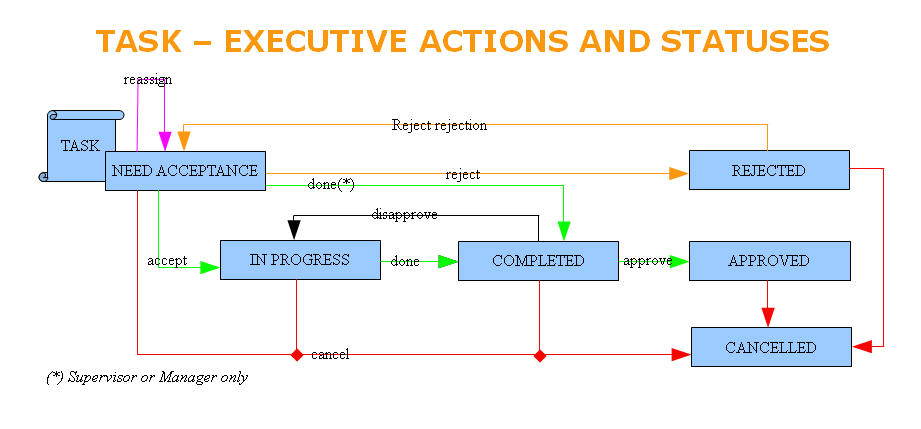Difference between revisions of "Task Manipulation"
| Line 1: | Line 1: | ||
This artical is made due to standardizing requirements when manipulating with task. Task is a resource which is very distinguish with others because it has many people get involed and spends on several phases in its cycle life. | This artical is made due to standardizing requirements when manipulating with task. Task is a resource which is very distinguish with others because it has many people get involed and spends on several phases in its cycle life. | ||
| + | |||
| + | = <span style="color: #ff9900">PEOPLE INVOLED</span> = | ||
The people are | The people are | ||
| Line 11: | Line 13: | ||
The life cycle of a task is quite complicated but in short description, since a task is created, it will be accepted to carry out by the responsible and end at approval or calcellation. And the workflow below is describing in more details | The life cycle of a task is quite complicated but in short description, since a task is created, it will be accepted to carry out by the responsible and end at approval or calcellation. And the workflow below is describing in more details | ||
| − | [[Image: | + | [[Image:TASK MANIPULATING.jpg]] |
| + | |||
| + | = <span style="color: #ff9900">STATUSES</span> = | ||
| + | |||
| + | In its life cycle, a task might spend on several statuses: | ||
| − | + | #NEED ACCEPTANCE : when created, a task needs to be assigned to someone. | |
| + | #IN PROGRESS : after being accepted, it goes to this status. | ||
| + | #REJECTED : or it might go to this status when the responsible thinks it is not true. | ||
| + | #COMPLETED : after making the issue working, the responsible sets it complete. | ||
| + | #APPROVED : the task's supervisor retests the issue and see it workign properly and approve it for good. | ||
| + | #CANCELLED : the supervisor can cancel the task whenever he/she see it no need to be fixed any more. | ||
| − | + | Besides, we can see that there are two loops in the workflow above. Those loops happen when it happens the confliction or disagreement between responsible and supervisor. Specificly, supervisor can reject responsible rejection to get the task status back to NEED ACCEPTANCE, or when the issue does neither working properly nor causing another issue after fixing, he/she will disapprove which get the task back to IN PROGRESS. | |
| − | |||
| − | |||
Revision as of 10:18, 8 July 2009
This artical is made due to standardizing requirements when manipulating with task. Task is a resource which is very distinguish with others because it has many people get involed and spends on several phases in its cycle life.
PEOPLE INVOLED
The people are
- Responsible : the person will take care the task.
- Supervisor : the person monitors the process of task execution.
- Observer : the person who concern the task executing process.
The life cycle of a task is quite complicated but in short description, since a task is created, it will be accepted to carry out by the responsible and end at approval or calcellation. And the workflow below is describing in more details
STATUSES
In its life cycle, a task might spend on several statuses:
- NEED ACCEPTANCE : when created, a task needs to be assigned to someone.
- IN PROGRESS : after being accepted, it goes to this status.
- REJECTED : or it might go to this status when the responsible thinks it is not true.
- COMPLETED : after making the issue working, the responsible sets it complete.
- APPROVED : the task's supervisor retests the issue and see it workign properly and approve it for good.
- CANCELLED : the supervisor can cancel the task whenever he/she see it no need to be fixed any more.
Besides, we can see that there are two loops in the workflow above. Those loops happen when it happens the confliction or disagreement between responsible and supervisor. Specificly, supervisor can reject responsible rejection to get the task status back to NEED ACCEPTANCE, or when the issue does neither working properly nor causing another issue after fixing, he/she will disapprove which get the task back to IN PROGRESS.
